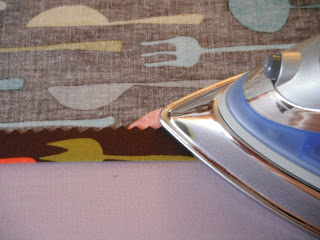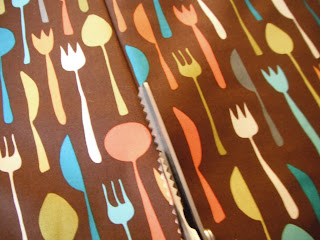Visit my Etsy store for unique gifts and accessories!
Wednesday, July 6, 2011
Sewing 101 - The Cafe Curtain
Of course I took sewing in school. We all did. For 4 weeks. We made a sack with a draw string and felt very proud of our accomplishment. School is where I first learned to thread a machine and do a straight stitch. Mom is the one who taught me how to read a pattern, how to transfer it to fabric, tricks for cutting it out, how to piece my item together and, generally, how to sew. Because of my Mom I can fit a sleeve into a shoulder, make a gather and stitch a pleat. If I forget what I'm doing, Mom is the person who talks me through it or stands over my shoulder while I run the machine.
My Mom taught me a number of tricks and because of her, I take no short cuts when I sew. She is the sewing equivalent of the handyman saying "Measure twice, cut once." Mom always said that if you take your time, and if you're patient, you can make anything.
Before we sew a purse lining, we're going to take this back to basics and make a curtain. No lining, no tabs. Just a simple rod-pocket cafe curtain. Before we get started with the tutorial, there are a few things you need to gather. Assuming you have a sewing machine (and it's accessories: needle, bobbins, etc), fabric, and thread I also recommend you make sure you have: measuring tape, lots of pins, ironing board and iron. If you think you can skip the pinning and/or ironing I would caution you to re-think your plan. My Mom has always said that the most important tools in sewing are: pins, an iron, and patience. She is so right.
Let's get started
The first thing you want to do is iron your fabric. You don't have to do this on the wrong side, but I tend to do that. This way if you have a dodgy iron, it won't leave any marks on the nice side of your fabric.
Btw, if you're having trouble figuring out which is the right or wrong side, look for the finished edge that shows the color grouping for the fabric. This is printed on the right side of the fabric, so the opposite side is the wrong side. In the case of this fabric, the wrong side is very clearly the lighter side with the faded pattern.
Measure & cut
Next you want to measure the length of your curtain.
In this example, I am making a curtain to be used as a "door" for the cabinet under my sink. So I measured the door opening, added an inch for the bottom hem and 4 inches for the top hem and rod pocket. Then I rounded up in case I made any mistakes measuring and also because I figured I could measure up from the hemmed bottom. I figured this at 30 inches and cut the length of the fabric at this measurement. I recommend folding the fabric and ironing on the fold. This will give you a nice straight line to follow while making your cut.
Depending on what you're making, you may decide to cut your fabric panel in half to make two curtains, which is what I did for my kitchen curtain.
I folded my panel in half & ironed down the middle. This gave me a nice, sharp edge to follow with my scissors. I opted for two panels because it gives easier access to the stuff under my kitchen sink. Depending on the width of your window (or door panel) you may opt to keep the entire width for your curtain.
Making a nice edge and bottom hem
Now we're going to finish the edges to make them neat & pretty. First fold over one unfinished edge and iron the edge down nice & flat.
Repeat this process on the opposite edge.
 |
| Pinking shears! |
Since I used pinking shears, I turned the fabric once to create a nice sharp edge and ironed to make a straight edge.
The next thing you want to do is pin the sides.
 |
| Do you see all those lovely pins? Told you I would use a lot. |
After you get the sides ironed down & pinned, you're ready to pin the bottom hem.
Follow the same process by ironing the fold and pinning to secure.
Time to sew!
Note you'll have three sides ironed and pinned for sewing. We'll do the top hem and rod pocket after we sew the sides and bottom.
Starting at the top of one side, sew a straight stitch down the length of the curtain.
 |
| Note this is not a fancy sewing machine. It's very basic and is really all you need for this type of sewing. |
Once you reach the end of the length, lift your foot (but keep the needle in the fabric) and turn the fabric 90 degrees to sew the bottom hem.
Take a close look at the picture above. You'll notice I sewed all the way to the bottom of the fabric. Using the reverse lever, back the stitch up to where you want to sew your bottom hem. Now turn your material 90 degrees and sew your bottom hem. If you don't now how to reverse stitch or if this is at all confusing, then don't sew all the way down the length of the fabric. Instead, stop where your bottom hem should be sewn and turn the fabric there. Just be sure to keep your needle in the fabric so that the stitches stay nice & tight and locked.After you sew the bottom hem, once again turn the fabric 90 degrees to sew up the length of the other side of the curtain. Once that is done, you will have three neat edges -- two sides and a bottom.
Make a rod pocket
Now we're going to finish the top of the curtain and make a rod pocket. The first thing you want to do is measure the curtain length you need from the bottom of the curtain.
Here's a neat little trick, measuring tape made for sewers had a hole at the bottom. If you pin this to the edge of your bottom hem, you now have two hands to measure, fold and pin your top edge.
For my curtain, I need a length of 23 inches for the door opening and 1/2 inch for a small top gather. (If I was making a curtain for a window, I would add enough fabric to make a larger gather at the top -- usually 1 to 1.5 inches.)
I measured 23.5 inches & made my top fold at that length.
Iron this fold the entire width of the fabric. Check your measurement every few inches to make sure you have a nice straight hem. Pin the fabric down, trim off any unnecessary fabric.
For some reason I'm missing the pictures for the next part of the process. Basically, what you're going to do is sew the top hem down, just like you did for the bottom. So you want a straight stitch across the lowest part of the fold to secure the hem. After this is completed, cut your threads and put your fabric back under the needle to make the rod pocket. Place your needle 1/2 inch from the top of the fold and make another straight stitch across the width of the fabric panel.
Once you have finished sewing, iron the panel to remove all wrinkles. Now repeat these steps with your 2nd curtain (if you have one.)
Now for the fun part
Now your curtains are done you can hang them. I used a small sash rod, which allows the curtain to lay nice & close on the door opening.
I'm really happy with the curtain. It looks great and the blue is perfect with my bottom kitchen cabinets. You couldn't buy this curtain and, if you could, it would cost a lot more than the $3 I paid for 1/2 yard of fabric.
Now that you've finished the cafe curtain tutorial, you have the skills to make a purse lining. I promise it's as simple as tracing, sewing a straight (or slightly curved) line and then fitting it in to the purse. The lining will require hand sewing. Please don't let that discourage you. I'm a terrible hand sewer but I'll show you a way to make stitches that are almost invisible and I promise, with practice, we'll both get better.
Hope you enjoy your new curtains!
Subscribe to:
Post Comments (Atom)











No comments:
Post a Comment